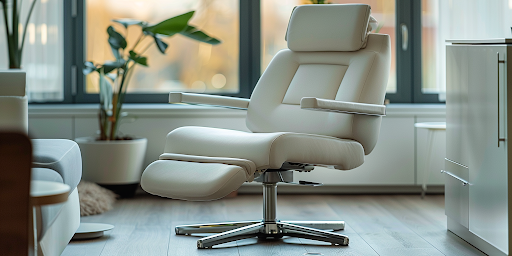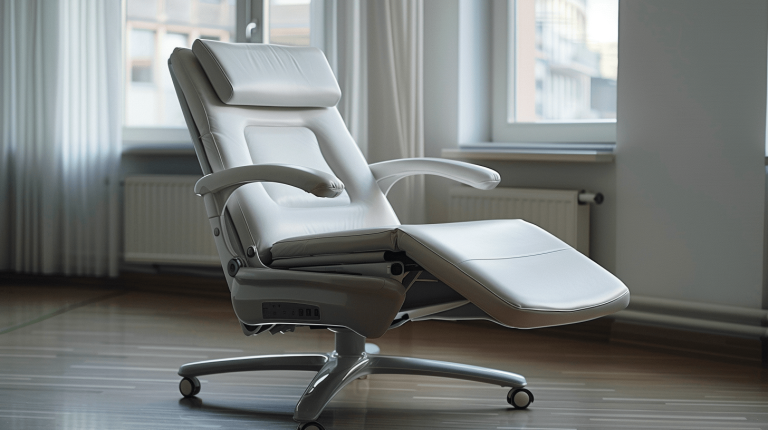Also known as medical seating, clinical chairs are specifically designed to be used in healthcare facilities. This type of chair helps ease discomfort and stress for patients who undergo surgery, imaging or other procedures.
What does a clinical chair do?
A clinical chair is designed to provide comfort and support to patients who must remain seated for long periods of time. Medical chairs also help staff position and move patients safely and efficiently.
Medical chairs benefit patients by providing support to sit comfortably and safely during the time they spend at a hospital or clinic. This reduces patients’ stress and fatigue. A treatment chair is especially useful when caring for patients with mobility difficulties. In addition to helping patients, medical chairs also help healthcare professionals move and position patients safely and easily. Medical seating chairs are designed to be easily adjusted enabling doctors and other medical staff to quickly and accurately position patients.
Why are clinical chairs important?
Clinical chairs offer a better experience for both patients and doctors. Offering patients a comfortable and ergonomic seating position significantly improves the quality of clinical care. And care providers will find it simplifies their duties. Both providers and their patients will benefit from a safer work environment.
Without the benefit of a medical chair, position positioning patients accurately is hard to achieve. For instance, placing a patient in a lateral direction would require medical staff to physically lift and turn the patient. But a clinical chair has easily accessible controls that allow it to rotate, be raised, be moved around, and more. These features have been created with the needs of staff in mind, making examinations much safer and easier.
6 benefits of clinical chairs
1. Improved blood flow and circulation
A recliner chair capable of handling multiple rotational directions can improve patient blood circulation. It can also provide unobstructed blood flow to the legs and feet. Poor blood circulation can lead to many complications and discomfort, so a well-designed patient chair provides a drastic improvement in treatment quality. This is especially true when caring for the elderly, because they might need to be seated for long periods of time.
Traditional phlebotomy chairs might not address a person’s wide range of potential complications, including their inability to sit down, move their limbs or sit still. Specialized patient chairs have adjustable armrests, neck rests, and other features that offer greater performance stability. Thanks to their modular design, chairs that are used to draw blood can be repurposed for multiple other clinical applications.
2. Creating a safe environment for patients and caregivers
Moving an individual from a pre-treatment position into a position that allows their examination can sometimes be a considerable challenge. Many patients can not sit down or stand up without assistance. Positioning patients also may require significant patient movements while also dealing with injuries such as broken bones. And the medical staff also runs the risk of becoming injured while helping a patient lean appropriately.
To ensure a safe experience for patients, clinical chairs are designed with a stable base and come equipped with a safe, easily operated brake. State-of-the-art clinical chairs are electrically operated and feature remote controls that can make correcting a patient’s position for medical diagnostics and procedures quick and easy to achieve.
Thanks to clinical ergonomic chairs, caregivers don’t have to risk their own well-being during medical practice. Instead of needing intense strength and stamina to push wheelchairs and transfer individuals from chairs to beds and back again, medical staff can rely on the chair’s functionality to aid them effortlessly during these procedures.
Clinical chairs for disability accommodations
3. Long-lasting comfort for patients
Offering people who are receiving medical care the maximum comfort is extremely beneficial to their well-being. Reducing the physical demand on patients in a sitting position helps them relax and have a positive medical experience. It is easy to get in and out of a clinical chair, and once a patient is on the chair, they can rely on multiple safety features to stay in the appropriate seating position. Because the entire chair is easily adjustable, it fits the ergonomic needs of people of all shapes, sizes and physical abilities.
4. Better stress relief
A common cause of discomfort for people receiving medical care is being actively aware of the performance of workers in the clinic. It is difficult for someone to relax while having to sit still in a longitudinal direction with medical staff performing procedures. A comfortable medical chair relieves stress, which allows patients to keep their minds busy with other more pleasant thoughts. The chair head, arms, and other components can be adjusted to suit each individual patient, providing the positional accuracy that their bodies need.
5. Improved functionality and versatility
Clinical chairs have a wide range of features designed to improve clinical practice. For example, the chair height is adjustable to ensure a person doesn’t slip away and can remain safely seated during the examination. The back of the chair and arm heights are also adjustable, which helps people with limited mobility achieve an upper body standing position. Additionally, clinical chairs are modular, non-porous, mildew resistant, and durable. This makes them incredibly easy to clean, which guarantees fewer germs.
6. Efficiently saves time
Using equipment specifically designed to ease the effort required to give patients a positive clinical experience also saves precious time. This cuts costs while allowing patients to spend less time in the clinic. A well-designed, high-quality clinical chair makes it quicker and safer to position patients for procedures such as scans, and reduces the time spent transferring them into various pieces of medical equipment. Because of their flexibility and versatility, some procedures can even be performed while the patient remains sitting in the clinical chair.
Shop for clinical chairs
A good medical chair should meet certain requirements such as durability, ergonomics, safety, and cost effectiveness. REAL clinical chairs are designed to offer the best therapeutic experience for both patients and healthcare professionals.
Featuring a durable steel frame, a reliable safety brake, as well as powered height, tilt, and reclined control, REAL clinical chairs offer impeccable security and comfort. REAL chairs have multiple clinical applications and are useful in all kinds of environments, including practice sites, clinical trials, medical education, and much more.
REAL chairs can help healthcare professionals address numerous challenges, such as performing X-rays or mammograms on people with reduced mobility or who have difficulty standing up. Because the entire chair is adjustable, it is not necessary for patients to get up and sit down multiple times when receiving treatment. REAL chairs can be used by individuals of all body types to aid them during rehabilitation and physical recovery.




